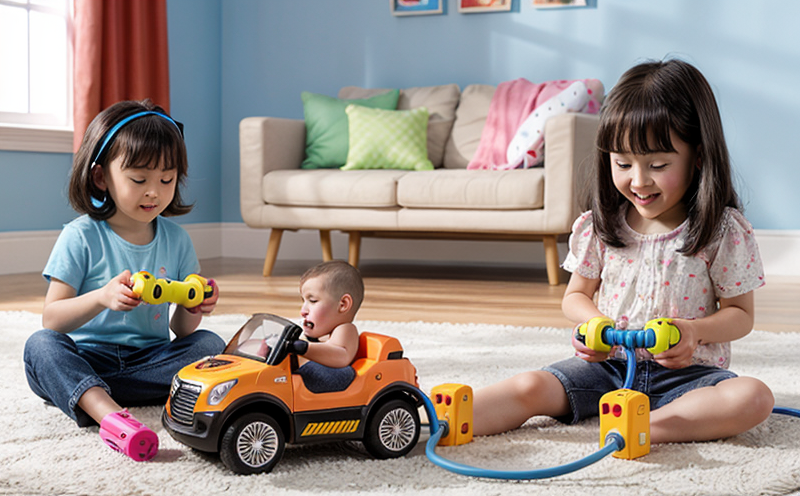EN 62115 Protection Against Moisture Test
The CENELEC standard EN 62115 specifies the protection against moisture requirements and test methods applicable to toys and similar products intended for use by children up to age 14. This service ensures that electrical and battery-operated toys meet strict safety standards, safeguarding children from potential hazards like electric shock or fire caused by water ingress.
Our EN 62115 Protection Against Moisture Test service is designed specifically for quality managers, compliance officers, R&D engineers, and procurement teams who need to ensure their products adhere to international safety regulations. By using this testing method, manufacturers can demonstrate that their toys are safe from moisture ingress under conditions likely to be encountered by children during normal use.
The test involves subjecting the toy to a series of environmental conditions intended to simulate real-world scenarios where water may come into contact with electronic components within the product. These tests include immersion in water, exposure to humidity, and condensation formation. The apparatus used for these tests includes specialized chambers that can control temperature, humidity levels, and other parameters required by the standard.
Acceptance criteria are defined based on the type of toy being tested and its intended age group. For instance, toys intended for children aged 3 to 5 must meet more stringent requirements than those designed for older children due to increased risk exposure. Compliance with EN 62115 ensures that manufacturers comply with relevant international standards such as ISO/IEC 80079-34:2018, which covers the protection against moisture in electrical equipment.
Our laboratory follows strict protocols during specimen preparation and testing to ensure accurate results. Specimens undergo thorough cleaning before being placed into the appropriate environmental chamber according to their design characteristics. During the test, we monitor critical parameters like temperature, humidity, voltage, current consumption, and leakage currents continuously throughout each phase of the procedure.
Reporting is comprehensive and includes detailed documentation outlining all aspects of the testing process, including any issues found during the evaluation. Additionally, our team provides recommendations for improvement based on identified weaknesses in performance or design flaws that could lead to non-compliance with EN 62115 requirements.
Why It Matters
The importance of protecting electrical and battery-operated toys against moisture cannot be overstated. Water ingress can cause short circuits, corrosion, and other failures that pose serious risks to children's health and safety. Compliance with EN 62115 not only protects consumers but also enhances brand reputation by demonstrating commitment to product safety.
By ensuring strict adherence to this standard, manufacturers reduce liability risks associated with defective products while maintaining market access in Europe and beyond. Moreover, compliance fosters trust among parents and caregivers who rely on these guidelines when selecting safe toys for their children.
Eurolab Advantages
At Eurolab, we offer unparalleled expertise in conducting EN 62115 Protection Against Moisture Tests. Our state-of-the-art facilities equipped with advanced instrumentation allow us to perform these tests accurately and consistently across all samples submitted.
- Accreditation: We are fully accredited by ISO/IEC 17025, ensuring the highest level of quality assurance for our testing services.
- Experience: Our team consists of experienced engineers and technicians who have extensive knowledge in electrical safety assessments.
- Technology: Utilizing cutting-edge equipment enables precise control over environmental conditions during testing.
- Compliance: We stay updated with the latest amendments to EN 62115, ensuring our practices align with current regulatory requirements.
We pride ourselves on providing reliable results backed by robust evidence collected throughout each test cycle. This approach guarantees that clients receive actionable insights they can use to improve product design and enhance overall safety features.
Use Cases and Application Examples
| Toy Type | Description | Test Conditions | Expected Outcomes |
|---|---|---|---|
| Battery-Powered Stuffed Animal | A plush toy featuring a small battery-powered light-up feature. | Immersed in water for 24 hours, then dried and retested for functionality. | No short circuits or electrical hazards detected after immersion. |
| Mechanical Ride-On Toy Vehicle | A child-sized vehicle with a built-in speaker system powered by AA batteries. | Exposed to high humidity conditions over 48 hours followed by drying and functional check. | No signs of corrosion or damage affecting performance observed. |
| Battery-Operated Educational Kit | A set containing various small electronic components used for teaching basic circuitry concepts. | Subjected to condensation formation within a sealed chamber for 12 hours before being inspected. | All parts remain intact without any signs of moisture-related degradation observed. |
- Baby Monitor: Ensuring the device continues functioning correctly even when accidentally exposed to water during use.
- Interactive Learning Tablets: Verifying that touchscreens and sensors operate reliably despite potential exposure to moisture from spills or humid environments.
- Digital Cameras for Kids: Confirming image quality remains unaffected after brief periods of rain or dew formation.
These examples illustrate the diverse range of applications where EN 62115 compliance is crucial. Proper protection against moisture helps maintain product integrity and enhances user experience while minimizing risks associated with electrical malfunctions.





